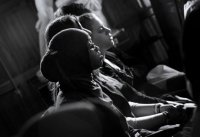Film as a Great Motivator
The high school social studies class has just gotten seated. The lights go out and a video projector immediately begins showing a scene from the film Boyz n the Hood. In the scene it's late at night and two black teenagers walking along a street, both nicely dressed, are stopped, thrown up against a wall and searched by two cops. One of the cops is black. The other is white. The teens are scared and angry. The black cop is physically aggressive and verbally hostile. Then the police just leave, one saying, "You have a good night."
The lights go on. The teacher asks the students to quickly write down a couple of sentences describing their thoughts and feelings while watching this. Students then share their thoughts in small groups.
A large group discussion focused on the race-related complexity of the interaction follows. The teacher then asks, "What does this have to do with the Trayvon Martin case?" The discussion continues. Finally, the teacher sums up the key issues explored in the lesson.
What Just Happened Here?
Notice the key features of this lesson:
- An emotionally charged scene from a film was used to immediately grab students' attention.
- Only a short scene was used, not a whole movie. That's all that was needed here.
- There is no narration in the film. The excerpt is totally open to student interpretation.
- There was no introduction by the teacher, no telling students what they were about to see, nor directions regarding how they should view it, or what they should think about or be looking for.
- The immediate follow-up included no teacher lecturing, initially focusing totally on the student thoughts and feelings.
The primary directives here are:
- If you want to effectively reach kids, grab them and hold their attention, you usually need to reach them emotionally.
- Commercial filmmakers have known this forever -- if they don't grab the audience, their film will fail -- while teachers, secondary school teachers especially, haven't fully accepted this.
- This generation of students is film and video oriented; we should use this, not bewail it.
Of course, film has been used in teaching for ages, but mostly in a very limited way. In social studies it's often been, "We've studied the '20's, now we'll see a movie about that period." And in English, "We’ve read To Kill a Mockingbird, now for the next few days we’ll watch the movie." This is okay, but requires viewing the whole film, doesn't effectively integrate the visual into the body of the curriculum, and implicitly sends the invalid message that film isn't as legitimate a form of communication as the written words used in the rest of the lesson.
Emotional Connection
It’s also important to note that this same method can be used in other subject areas. In a science classroom, students have no sooner landed when the lights go out and the film Fire Mountain begins. They watch powerful visual images capturing the eruption of Mt. Kilauea, filled with close-ups of explosions and molten lava. There is no narration, just an engaging musical soundtrack. The lights go on and there is no immediate discussion. Instead students are asked to close their eyes and imagine how they would have responded if they'd been camping near the base when the mountain exploded. Their experiences are shared in small groups. Then the lesson moves into an introduction to the new unit on plate tectonics.
An algebra teacher I know began her unit on word problems with a brief excerpt from The Simpsons in which Bart has a hilarious meltdown when given a word problem to solve. She followed the laughter with a brief discussion about the anxiety some students have related to word problems. Her theory was that the comic video would help relax them and help many of them understand that they weren't alone in their anxiety. She told me this strategy worked so well that she has now incorporated it into that unit every semester.
The Power of Visual Media
This isn’t the only legitimate use of film in the classroom. Film can be used as a culminating experience to summarize a unit or lesson. It can be studied as an art form. Short films designed to teach a concept or skill, especially in a subject like physical education, can be very useful. Developing students' critical consciousness of visual media should be a major part of every school's curriculum and is important enough a subject to be the focus of a forthcoming column.
Once you become tuned into using film in the classroom in a multiplicity of ways, you'll find yourself frequently seeing scenes in films in theaters, on DVDs or in TV shows that will immediately register as ones you'd like to use. Keep a notebook or a computer file to jot down the reminders. Also, unlike the old days of videotape, the scenes or chapters on DVDs and Blu Ray discs make quick access easy.
One final word. The great film critic Pauline Kael, addressing a group of educators years ago, said, "If you don't think education can ruin film, you underestimate the power of education." She was referring to the fact that one of our pleasures in film is that it entertains us, and there is nothing more deadening to entertainment than either a dull film or a dull analytical discussion following a film. There is no contradiction between a film being entertaining and also educationally effective. So, as you know your audience, select films they'll enjoy.
